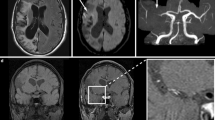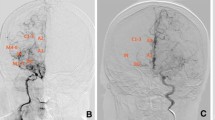Abstract
Introduction
Cerebral punctate and curvilinear gadolinium enhancements (PCGE) correspond to opacification of small vessel lumen or its perivascular areas in case of blood-brain barrier (BBB) disruption. We will discuss the possible causes of intra-parenchymal central nervous system PCGE.
Methods
Our review is based on French database including patients presenting with central nervous system PCGE and literature search using PubMed database with the following keywords: punctate enhancement, linear enhancement, and curvilinear enhancement. Disorders which displayed linear leptomeningeal or periventricular enhancements without intra-parenchymal PCGE are excluded of this review.
Results
Among our 39 patients with PCGE, 16 different diagnoses were established. After combining our PCGE causes with those described in the literature, we propose a practical approach. Besides physiologic post-contrast enhancement of small vessels, three pathologic conditions may exhibit PCGE: (1) small collateral artery network seen in Moyamoya syndrome, (2) small veins congestions related to developmental or acquired venous outflow disturbance, and (3) disorders causing small vessels BBB disruption indicated by T2 and FLAIR hyperintensities in the corresponding areas of PCGE. Disruption of the BBB could be caused by a direct injury of the endothelial cell, as in posterior reversible encephalopathy syndrome, Susac syndrome, and radiochemotherapy-induced injuries, or by an angiocentric cellular infiltrate, as in inflammatory disorders, demyelinating diseases, host immune responses fighting against infections, prelymphoma states, lymphoma, and in CLIPPERS.
Conclusion
PCGE may conceal several causes, including physiological and pathological conditions. Nevertheless, a practical approach could improve its management and limit the indications of brain biopsy to very specific situations.







Similar content being viewed by others
Abbreviations
- DWI:
-
Diffusion-weighted images with increased
- ADC:
-
Apparent diffusion coefficient
- BBB:
-
Blood-brain barrier
- MRI:
-
Magnetic resonance imaging
- PCGE:
-
Punctate and curvilinear gadolinium enhancements
- SWI:
-
Susceptibility-weighted imaging
- T1WI:
-
T1-weighted images
- T2WI:
-
T2-weighted images
- PRES:
-
Posterior reversible encephalopathy syndrome
- SLE:
-
Systemic lupus erythematosus
- LCH:
-
Langerhans cell histiocytosis
- NLCH:
-
Non-Langerhans cell histiocytosis
- PCACNS:
-
Primary arteritis of the CNS
- ADEM:
-
Acute demyelinating encephalomyelitis\
- MS:
-
Multiple sclerosis
- NMOSD:
-
Neuromyelitis optica spectrum disorders
- IRIS:
-
Immune reconstitution inflammatory syndrome
- PML:
-
Progressive multifocal leukoencephalopathy
- PCNSL:
-
Primary CNS lymphoma
- LYG:
-
Lymphomatoid granulomatosis
- IVL:
-
Intravascular lymphoma
- CLIPPERS:
-
Chronic lymphocytic inflammation with pontine perivascular enhancement responsive to steroids
References
Carr JC, Carroll TJ (eds) (2012) Magnetic resonance angiography, principles and applications. Springer, New York, pp 215–216
Pittock SJ, Debruyne J, Krecke KN et al (2010) Chronic lymphocytic inflammation with pontine perivascular enhancement responsive to steroids (CLIPPERS). Brain 133:2626–2634
Tateishi U, Terae S, Ogata A, Sawamura Y, Suzuki Y, Abe S, Miyasaka K (2001) MR imaging of the brain in lymphomatoid granulomatosis. AJNR Am J Neuroradiol 22:1283–1290
Taieb G, Duflos C, Renard D et al (2012) Long-term outcomes of CLIPPERS (chronic lymphocytic inflammation with pontine perivascular enhancement responsive to steroids) in a consecutive series of 12 patients. Arch Neurol 69:847–855
Uysal E, Erturk SM, Yildirim H et al (2007) Sensitivity of immediate and delayed gadolinium-enhanced MRI after injection of 0.5 M and 1.0 M gadolinium chelates for detecting multiple sclerosis lesions. AJR Am J Roentgenol 188:697–702
Friedman DP (1997) Abnormalities of the deep medullary white matter veins: MR imaging findings. AJR Am J Roentgenol 168:1103–1108
Komiyama M, Nakajima H, Nishikawa M et al (2001) Leptomeningeal contrast enhancement in moyamoya: its potential role in postoperative assessment of circulation through the bypass. Neuroradiology 43:17–23
Bartynski WS (2008) Posterior reversible encephalopathy syndrome, part 2: controversies surrounding pathophysiology of vasogenic edema. AJNR Am J Neuroradiol 29:1043–1049
Susac JO, Murtagh FR, Egan RA et al (2003) MRI findings in Susac’s syndrome. Neurology 61:1783–1787
Jennings JE, Sundgren PC, Attwood J et al (2004) Value of MRI of the brain in patients with systemic lupus erythematosus and neurologic disturbance. Neuroradiology 46:15–21
Christoforidis GA, Spickler EM, Recio MV et al (1999) MR of CNS sarcoidosis: correlation of imaging features to clinical symptoms and response to treatment. AJNR Am J Neuroradiol 20:655–669
Prayer D, Grois N, Prosch H et al (2004) MR imaging presentation of intracranial disease associated with Langerhans cell histiocytosis. AJNR Am J Neuroradiol 25:880–891
Sedrak P, Ketonen L, Hou P et al (2011) Erdheim-Chester disease of the central nervous system: new manifestations of a rare disease. AJNR Am J Neuroradiol 32:2126–2131
Forbes KP, Collie DA, Parker A (2000) CNS involvement of virus-associated hemophagocytic syndrome: MR imaging appearance. AJNR Am J Neuroradiol 21:1248–1250
Jennette JC, Falk RJ, Bacon PA et al (2013) 2012 revised International Chapel Hill Consensus Conference Nomenclature of Vasculitides. Arthritis Rheum 65:1–11
Chenevier F, Renoux C, Marignier R et al (2009) Primary angiitis of the central nervous system: response to mycophenolate mofetil. J Neurol Neurosurg Psychiatry 80:1159–1161
Sakaguchi H, Ueda A, Kosaka T et al (2011) Cerebral amyloid angiopathy-related inflammation presenting with steroid-responsive higher brain dysfunction: case report and review of the literature. J Neuroinflammation 8:116
Young NP, Weinshenker BG, Parisi JE et al (2010) Perivenous demyelination: association with clinically defined acute disseminated encephalomyelitis and comparison with pathologically confirmed multiple sclerosis. Brain 133:333–348
Guttmann CR, Ahn SS, Hsu L et al (1995) The evolution of multiple sclerosis lesions on serial MR. AJNR Am J Neuroradiol 16:1481–1491
Pekcevik Y, Izbudak I (2015) Perivascular enhancement in a patient with neuromyelitis optica spectrum disease during an optic neuritis attack. J Neuroimaging 25:686–687
Post MJ, Thurnher MM, Clifford DB et al (2013) CNS-immune reconstitution inflammatory syndrome in the setting of HIV infection, part 1: overview and discussion of progressive multifocal leukoencephalopathy-immune reconstitution inflammatory syndrome and cryptococcal-immune reconstitution inflammatory syndrome. AJNR Am J Neuroradiol 34:1297–1307
Wattjes MP, Verhoeff L, Zentjens W et al (2013) Punctate lesion pattern suggestive of perivascular inflammation in acute natalizumab-associated progressive multifocal leukoencephalopathy: productive JC virus infection or preclinical PML-IRIS manifestation? J Neurol Neurosurg Psychiatry 84:1176–1177
Lescure FX, Moulignier A, Savatovsky J et al (2013) CD8 encephalitis in HIV-infected patients receiving cART: a treatable entity. Clin Infect Dis 57:101–108
Sanelli PC, Lev MH, Gonzalez RG et al (2001) Unique linear and nodular MR enhancement pattern in schistosomiasis of the central nervous system: report of three patients. AJR Am J Roentgenol 177:1471–1474
Taieb G, Uro-Coste E, Clanet M et al (2014) A central nervous system B-cell lymphoma arising two years after initial diagnosis of CLIPPERS. J Neurol Sci 344:224–226
Patsalides AD, Atac G, Hedge U et al (2005) Lymphomatoid granulomatosis: abnormalities of the brain at MR imaging. Radiology 237:265–273
De Graaff HJ, Wattjes MP, Rozemuller-Kwakkel AJ et al (2013) Fatal B-cell lymphoma following chronic lymphocytic inflammation with pontine perivascular enhancement responsive to steroids. JAMA Neurol 70:915–918
Epaliyanage P, King A, Hampton T, Gullan R, Ashkan K (2014) “Brain on fire”: a new imaging sign. J Clin Neurosci 21:2015–2017
Faivre G, Lagarde J, Choquet S et al (2014) CNS involvement at diagnosis in mantle cell lymphoma with atypical MRI features. J Neurol 261:1018–1020
Yamamoto A, Kikuchi Y, Homma K et al (2012) Characteristics of intravascular large B-cell lymphoma on cerebral MR imaging. AJNR Am J Neuroradiol 33:292–296
Liow K, Asmar P, Liow M et al (2000) Intravascular lymphomatosis: contribution of cerebral MRI findings to diagnosis. J Neuroimaging 10:116–118
Simon NG, Parratt JD, Barnett MH et al (2012) Expanding the clinical, radiological and neuropathological phenotype of chronic lymphocytic inflammation with pontine perivascular enhancement responsive to steroids (CLIPPERS). J Neurol Neurosurg Psychiatry 83:15–22
Acknowledgments
We want to especially thank Mr Benjamin Taieb for his help in figure design.
Author information
Authors and Affiliations
Corresponding author
Ethics declarations
We declare that this manuscript does not contain clinical studies. Anonymized data with a number were used to develop a practical approach.
Conflict of interest
We declare that we have no conflict of interest.
Rights and permissions
About this article
Cite this article
Taieb, G., Duran-Peña, A., de Chamfleur, N.M. et al. Punctate and curvilinear gadolinium enhancing lesions in the brain: a practical approach. Neuroradiology 58, 221–235 (2016). https://doi.org/10.1007/s00234-015-1629-y
Received:
Accepted:
Published:
Issue Date:
DOI: https://doi.org/10.1007/s00234-015-1629-y




